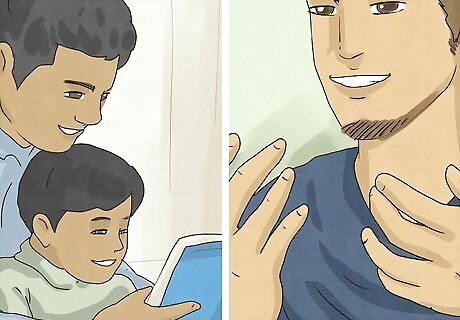
views
What are the symptoms of selective mutism in children?

Kids with SM suffer from a consistent inability to talk in a specific setting. They often can't speak in social situations where talking is expected but speak normally in other settings. Their lack of speech is not by choice but rather caused by extreme anxiety that makes talking difficult. For example, some children with SM can talk to other kids but not adults, while others talk freely at home but can't speak in school. Kids with selective mutism may also: Struggle to make eye contact and appear shy Answer questions wordlessly by pointing or nodding Speak through other individuals (like whispering to a friend or parent) Cry or throw a tantrum when someone asks them to speak Cling to a parent/caregiver, or hide when other people come near Symptoms will last longer than one month, not including the time it takes to adjust to a new environment—which usually takes another month—and can't be blamed on unfamiliarity with the language or another disability, such as autism.
Supporting Children with Selective Mutism

Offer positive reinforcement. Be encouraging and supportive of your child rather than punishing or criticizing them for being silent. Children are sensitive and need a calm, positive role model to help them overcome SM. Give them enthusiastic praise when they find ways to communicate, whether it's a simple hand gesture or speaking. This will motivate them to continue talking. For example, if you smile and tell your child "Great job!" when they make a gesture to communicate, they'll want to communicate more. You can also give your child a small treat or toy to encourage improvement; they might be even more motivated to reach new speech milestones if they know they'll get a well-deserved reward for their hard work.

Use augmentative and alternative communication (AAC) with your child. Before they overcome SM, it's helpful to give them different, non-stressful ways to communicate. Figure out what form of communication they prefer, and let them use that to interact with others. This is temporary, as the ultimate goal is to work through selective mutism rather than around it. However, it helps them "speak" in the meantime. AAC may involve hand gestures, written words, or communication boards with symbols that your child can point to.

Try stimulus fading to gradually overcome selective mutism. Start with your child talking to someone they can interact with freely (like you), and then slowly introduce someone new into the conversation. Have them talk to the person they're comfortable with first and work their way up to speaking with the person they're least confident around. Over time, the anxiety will fade. This is why the technique is called "stimulus fading." The discomfort progressively decreases as your child gets used to anxiety-inducing interactions over time alongside people they're comfortable with.

Use shaping exercises to familiarize them with spoken conversations. Encourage your child to communicate by teaching them gestures before graduating to noises, letter sounds, and eventually full speech. Help them practice regularly so they become more daring with communication over time. Other people can help your child with shaping exercises too! Speak to other family members and teachers about this so they can offer encouragement at each milestone.

Ask your child choice-based questions. Make sure each question requires the child to give an answer beyond "yes" or "no," but also doesn't force them to speak at length. This gets them used to communicating with more than just nodding or shaking their head. After they answer, thank your child warmly for communicating with you. Try questions like, "Do you like sandwiches or pizza better?" and "Would you rather go to the park or the museum today?"

Make anxiety-provoking environments more comfortable for them. Introduce your child to whole groups of people, but do it one person at a time and take it slowly so they can get used to each person before moving on. Stay with them unless your child asks for space, so they have a supportive figure to intervene if they become frightened or stressed. Teach your child that they don't have to avoid every source of anxiety in their life, as this will reinforce general avoidant behavior.

Enjoy shared activities that don't require speaking. Try engaging your child with arts and crafts, play a game of catch or frisbee, or ask them to watch a movie with you. Nonverbal activities let your child relax, have fun and strengthen their bond with you without having to worry about direct verbal communication. Make sure your child knows that being unable to speak isn't a failure on their part, and they can still have fun and enjoy life without using verbal communication.

Be patient with them. Give your child time to warm up, think about their answers, and let them hesitate if they need to. Don't demand a response right away or cut them off and move on if they're having trouble answering. Create a safe space by making it clear that you accept your child as they are and that you're happy to wait, which will help them relax and feel comfortable speaking with you. Accept nonverbal communication without expecting more from your child or imposing a time frame on their improvement. Developing comfort is an essential step in overcoming SM, so take the time to make sure your child is comfortable with you.

Encourage your child to use positive thinking and cognitive reframing. The idea behind cognitive reframing is that negative thoughts lead to negative behavior; in other words, if your child only tells themselves, "I can't talk," it's difficult to reverse the effects of SM. However, they can reframe this perspective by building a more positive attitude. "I can try to talk, and if I work at it, one day I will!" Remind your child to catch themselves when they think something negative. If they start thinking, "this is impossible," they can correct that to, "this is possible, and I can do it." Eventually, reframing their thoughts will be second nature, and you'll notice a change in your child's behavior as their outlook improves. This technique also teaches kids to reflect and analyze their thoughts and feelings, which is a useful skill!
Getting Your Child Professional Treatment for Selective Mutism

Talk to a doctor for a formal diagnosis. While you can compare and identify symptoms independently, only a qualified professional can ultimately determine whether your child has selective mutism. Diagnosing SM includes a speech evaluation, interviews with family or teachers, and collaboration with other healthcare professionals, including a psychologist, pediatrician, and guidance counselor. Interviews with family help SM specialists better understand your child's symptoms, how long they've been around, and get a sense of your child's home environment.

See a psychologist for cognitive behavioral therapy (CBT). If you have the means, the most rapidly effective treatment for SM is therapy. A therapist can help your child gradually expose themselves to new forms of communication and manage their behavior. They can also offer additional support and introduce your child to helpful techniques like stimulus fading and cognitive reframing.

Ask a psychiatrist about anxiety medication for an older child. Since selective mutism is an anxiety disorder, antidepressants (called selective serotonin reuptake inhibitors or SSRIs) are sometimes used to treat it. However, remember that medicine isn't supposed to replace therapy as treatment. Any child taking medication for SM should have CBT as well. SSRIs are usually only prescribed for children ages 8 and up who have a challenging case of selective mutism.
















Comments
0 comment